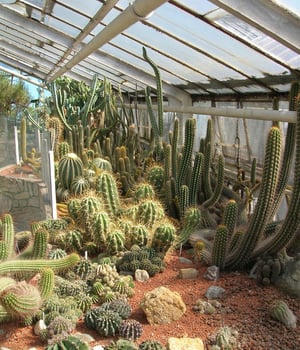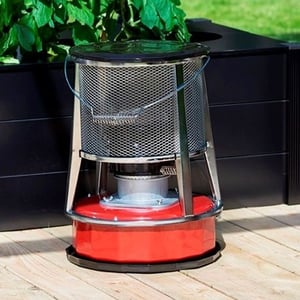How to Heat a Greenhouse
Written by Matt W (Greenhousestores) on 23rd Jan 2020.

Greenhouses help us produce more food for a longer time - we know this already! But what if we went the extra step and took our greenhouse to the next level? Greenhouses alone can extend the growing season by months - without any extra heating.
Summertime means keeping your vents open in order to keep your plants happy, but winter means a dead pause in our climate unless you plant only vegetables that thrive in low temperatures.
If you like kale but are ready for something more, consider what a busy gardener you will be if you decide to invest in a heating system for your greenhouse - winter won’t mean downtime at all.
What hothouse heating methods are available to gardeners? A lot! Some are even free. Here is a short rundown of methods that might work for you. It all depends where you live, how cold it gets there, and how sheltered your greenhouse is.
Here are a few things to bear in mind:
Heat Sinks
Heat sinks absorb heat easily and release them when it’s cold. This is a good no-energy and no-cost method for small greenhouses. What works well as a heat sink?
Plastic bottles - if you fill a plastic bottle with water and paint it black, it will act as a natural heat absorbent. Put several plastic bottles around your greenhouse and they will gather all the energy they can over the course of a day, and release it back into the greenhouse. It might not be much, but it’s good enough to make a small difference if you don’t live in the arctic. In fact, it’s a very useful method for when the days are still a bit longer.
Thermal mass floor - if you opt for a concrete slab floor, it will act as a heat sink too. Some people choose not to pave the inside of their greenhouse, and that’s fine - but remember that having some concrete slabs will help you control the environment more. And while everything runs free and wild outside - a greenhouse is a controlled environment by definition!
Insulation
Insulation is probably the most important aspect of heating - because if you have a “leaky” structure, you’ll be heating the great outdoors instead of the inside of your greenhouse.
One of the best ways to insulate a greenhouse is to wrap it in bubble wrap. It’s the perfect material for insulation because a) you can get it anywhere b) air pockets on bubble wrap act as the perfect insulation, and most importantly c) it’s clear and lets in light.
If you happen to have spare packaging bubble wrap lying around, that’s great - but keep in mind that since this method works so well, gardening stores now have a special horticultural grade bubble wrap. It’s stronger and will weather it through more snow, wind, rain and UV lightning than normal bubble wrap.
Important tip - clean your windows before taping/stapling on your bubble wrap. This will help keep the loss of light to a minimum.
Heating

Now that we know a bit about insulation, here are some options for heating a greenhouse. There are a few different schools of greenhouse heating depending on how big your greenhouse is and what you want to grow inside. Some gardeners need to keep the temperature just above freezing for vegetating plants, while others want to maintain their plants cosy and active over the winter.
There are the DIY heaters and heating hacks, and the more professional “plug and play” heaters. See what works best for you.
On the cheap
Candles and a clay pot will get you surprisingly far for a short while. If you have a smaller greenhouse, putting tealights in a pot will actually help keep your greenhouse warmer, but we have to say that it isn’t the best idea simply because the open flame can be dangerous, and the amount of generated heat is very limited. We wanted to include this method because it seems to be all the rage on DIY blogs and videos.
We have seen clever setups where the pot hangs on a chain - and this might seem like a useful and aesthetically pleasing idea in a greenhouse, but we have also seen these chains heat up so much that they become a fire hazard! In addition, one tea candle can generate somewhere around 30w of heat. In a greenhouse, this can add up to a mountain of tea lights fairly quickly. While this is a good idea to heat up a room that you’re in the moment or in an emergency, it doesn’t pass the test as a sustainable and inexpensive heating source.
Compost, on the other hand, is both sustainable and effective. If you have ever walked near a compost pile in the winter, you will have certainly noticed that it creates steam. In fact, a compost pile can even spontaneously combust if not properly attended!
This is a method that’s been in use for almost a century. During the 1940s people used decomposing straw to heat their greenhouses - this is probably because fuel was scarce during the war. This is a simple system of ventilation that circulates the air through pipes in the warm compost and into the greenhouse. Some technical know-how is required. Remember, that in order for your compost to start “working”, you will need 9 cubic feet of biomass.
This is perfect for us, as we can harness the energy that decomposition generates and use it to heat our greenhouse.
If you have a large compost heap somewhere in the vicinity, piping in the heat is a tempting idea. This is a great idea for someone who runs a large allotment - in some cases, you can explore coordinating with your neighbours on a large compost pile so you can all use the heat in the winter.
If you don’t have a huge mountain of compost, but your greenhouse is standing on soil and doesn’t have a floor, an option is to dig into the ground in order to make “floor heating” like shown here.
A “Hotbin” is a solution for you if you don’t want to dig in your greenhouse, don’t have a huge pile of compost and like things to be on the neater side. Here are some ideas from Permaculture.co.uk
Easy Peasy Store-bought
Soil Warming Cable - if you ever walked on a gently heated bathroom floor on a cold winter day, you will know what your plants will feel when overwintering in warm earth. Yes, soil heaters are a thing now. They even look like home floor warming systems when you put them down. Here is a quick guide to our Elite Soil Warming Cable:
Spacing of the cable
2” (50mm) will give a load of 20w per sq ft
3” (75mm) will give a load of 15w per sq ft
4” (100mm) will give a load of 10w per sq ft
5” (125mm) will give a load of 8.5w per sq ft
6” (150mm) will give a load of 7.5w per sq ft
8” (200mm) will give a load of 5w per sq ft
This cable is buried in the sand (which helps to conduct the heat naturally and helps to save power) and is then covered with growing soil.
What’s great about these cables is that they can also be used outside of the soil for warming the air.
Juliana Kerosene Heater

Here is a great option if your greenhouse doesn’t have electrical access and you don’t want to trail extension leads through your garden in the rain and snow. Something about that just doesn’t sound safe. We have this kerosene heater in stock, and the delivery is free.
This kerosene heater can heat greenhouses that are up to 15 square meters.
Tip: Remember that when heating your greenhouse, ventilation is also very important. Humidity isn’t good, and heating can create a lot of humidity. Make sure to keep your greenhouse ventilated, so the air can circulate and the moisture can dissipate.
Another perfect solution for running greenhouse heating electricity-free is a propane heater that runs off a tank. Energy-saving with low gas consumption. Greenhouse Stores has a range of them in stock here. A great bonus is that a lot of them can be serviced by the manufacturer, which keeps them in top shape for years to come.
Electric heaters aren’t as expensive to operate as they used to be. If you have electricity access in your greenhouse, or better yet - if you are thinking of operating “off the grid” and powering your greenhouse with solar panels, this is a perfect solution for you.
We love the Hotbox Levant 1.8kw heaters because they hang high up from the structure frame, and they help to circulate the air better than any other heater. This helps to keep any fungal visitors away and helps to manage humidity.
In conclusion
We think that heating a greenhouse is a must in order to take your gardening game to the next level. You should consider all of the options that we outlined in this article - it’s best to combine, mix and match and above all - insulate well.
Keep an eye out for upcoming how-to articles about environmentally friendly heating with heat pumps, solar, and wind.